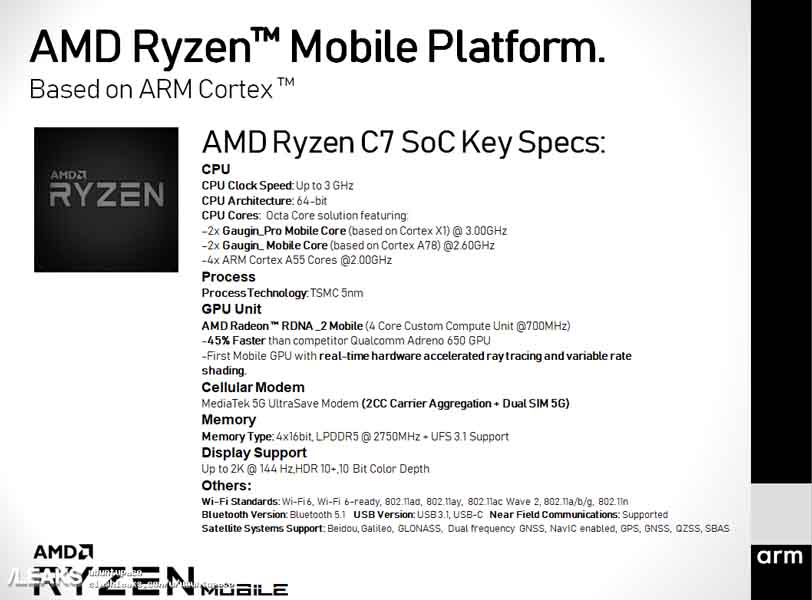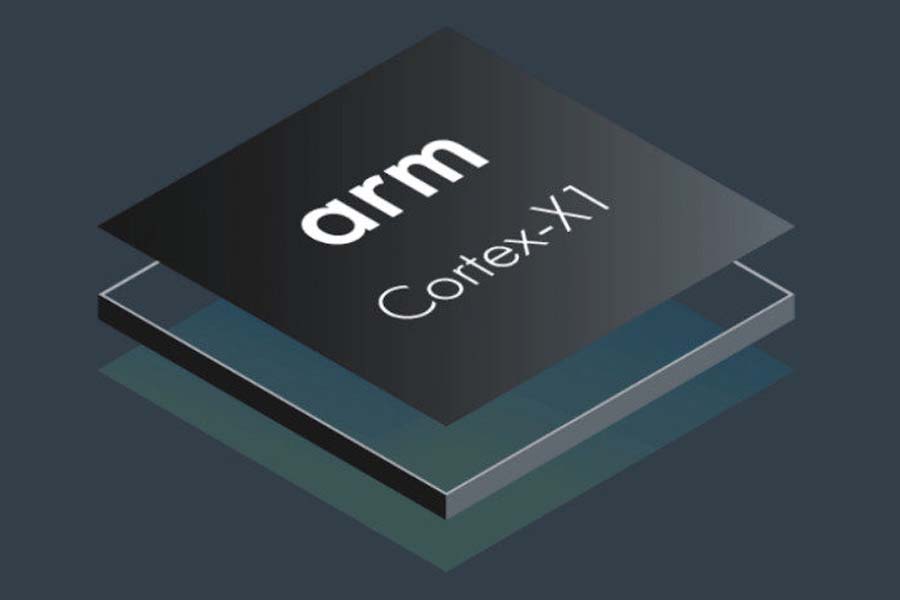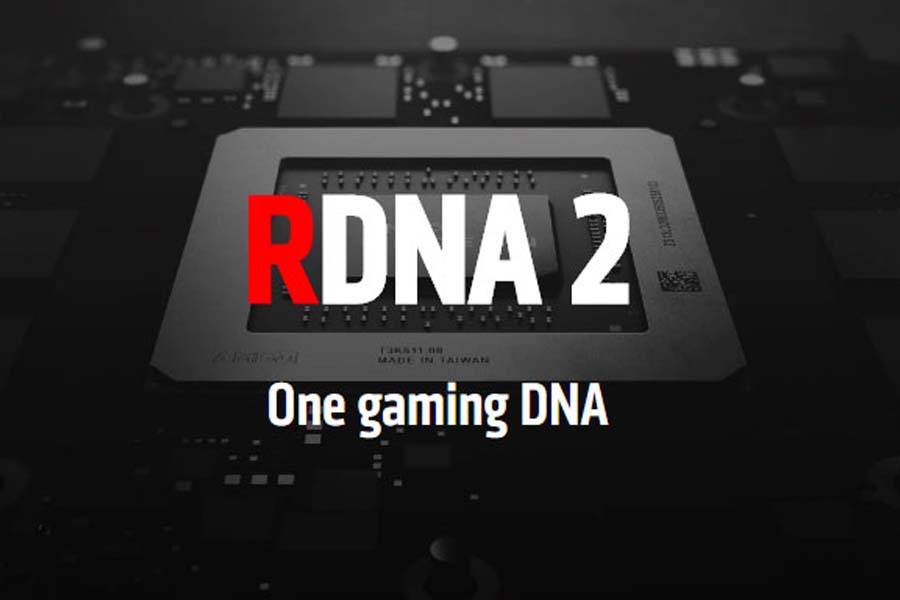Advanced Micro Devices (AMD)’s success story is one for the ages. A company that was once in the brink of bankruptcy, is now ruling the consumer-grade as well as workstation-grade CPUs with its new Ryzen, Threadripper, and EPYC lineup of processors. While its direct-competitor Intel is still playing catch-up with AMD, the company has successfully built a good rapport with its customers which will help its market dominance in the long-run. And a recent leak suggests that AMD will try to replicate that success in the smartphone chipset business as well. The chipset in question is the Ryzen C7 from AMD. According to the image, Ryzen C7 has 2x Gaugin Pro and 2x Gaugin cores among others. However, it most likely is referring to Paul Gauguin – a French artist from the mid-1800s, further discrediting the leak in the process. Having said that, misspelling certain aspects are common and clever tactics to avoid any sort of NDA (Non-Disclosure Agreement) violation. So, with this little two-sided argument I’ve made, let’s take a closer look at what the Ryzen C7 SoC features – according to the leak.
According to the image, Ryzen C7 has 2x Gaugin Pro and 2x Gaugin cores among others. However, it most likely is referring to Paul Gauguin – a French artist from the mid-1800s, further discrediting the leak in the process. Having said that, misspelling certain aspects are common and clever tactics to avoid any sort of NDA (Non-Disclosure Agreement) violation. So, with this little two-sided argument I’ve made, let’s take a closer look at what the Ryzen C7 SoC features – according to the leak. The primary difference between X1 and A78 is performance. This is pulled off by physically increasing the core structure. In terms of benchmark scores, the Cortex-X1 delivers +30% and +22% integer performance over Cortex-A77 and A78 cores respectively. Similarly, it achieves 2x machine learning performance against the same A77 & A78 cores. But as I said earlier, it actively understates the other two aspects of the PPA (Power, Performance, Area) triangle. As a result, the performance-bump comes at a significant power usage, which is projected to be up to 2x of Cortex-A77/78.Till now, Samsung has partnered up with Arm in its Cortex-X Custom Program while other customers are likely to make the announcement pretty soon. Seeing how Samsung abandoned its “Mongoose” custom CPU design in favor of staying competitive against Qualcomm, the partnership was not a surprise at all. From now on, the company will be licensing Arm’s CPU core design instead of just the IP (Intellectual Property), unlike Qualcomm.Also Read: Galaxy S20+ difference between Exynos and Snapdragon variantsAnd the leak suggests AMD is going the Qualcomm way here. Its 2x high-performance Gaugin_Pro Mobile Core (clocked at 3.00GHz) and 2x Gaugin_Mobile Core (clocked at 2.60GHz) are the slightly modified versions of their Cortex counterparts. So, we expect even better energy efficiency on these CPUs; provided the Ryzen C7 actually exists. Finally, AMD hasn’t fiddled with the remaining four CPUs being the ultra-high efficient Cortex-A55 cores clocked at 2.00GHz.
The primary difference between X1 and A78 is performance. This is pulled off by physically increasing the core structure. In terms of benchmark scores, the Cortex-X1 delivers +30% and +22% integer performance over Cortex-A77 and A78 cores respectively. Similarly, it achieves 2x machine learning performance against the same A77 & A78 cores. But as I said earlier, it actively understates the other two aspects of the PPA (Power, Performance, Area) triangle. As a result, the performance-bump comes at a significant power usage, which is projected to be up to 2x of Cortex-A77/78.Till now, Samsung has partnered up with Arm in its Cortex-X Custom Program while other customers are likely to make the announcement pretty soon. Seeing how Samsung abandoned its “Mongoose” custom CPU design in favor of staying competitive against Qualcomm, the partnership was not a surprise at all. From now on, the company will be licensing Arm’s CPU core design instead of just the IP (Intellectual Property), unlike Qualcomm.Also Read: Galaxy S20+ difference between Exynos and Snapdragon variantsAnd the leak suggests AMD is going the Qualcomm way here. Its 2x high-performance Gaugin_Pro Mobile Core (clocked at 3.00GHz) and 2x Gaugin_Mobile Core (clocked at 2.60GHz) are the slightly modified versions of their Cortex counterparts. So, we expect even better energy efficiency on these CPUs; provided the Ryzen C7 actually exists. Finally, AMD hasn’t fiddled with the remaining four CPUs being the ultra-high efficient Cortex-A55 cores clocked at 2.00GHz. Yet, the RDNA GPU technology had already made headlines in a different leak. It is supposed to feature on Samsung’s upcoming Exynos 1000 SoC substituting Arm’s Mali GPU. With this move, the Exynos 1000 reportedly brags nearly 3x better performance than Qualcomm’s latest Adreno 650 GPU in GFXBench’s Aztec Ruins (High) test. Regardless, the RDNA 2 Mobile on Ryzen C7 claims 45% faster performance than the Adreno 650.Additionally (and this is quite the big one), this GPU will also go on to grab the title for the world’s first mobile GPU with “real-time hardware-accelerated ray tracing and variable rate shading”. In case you don’t know, ray tracing is a rendering technique to deliver realistic lighting effects in fields like gaming, CGI, animation, etc. Popularized by NVIDIA’s RTX lineup of graphics cards, real-time ray tracing has become one of the most sought-after features in recent GPUs. Though NVIDIA had also released a driver-based solution to enable ray tracing for its GTX 10 and 16 series of GPU, their hardware limitation simply couldn’t compete with the ones from RTX cards.
Yet, the RDNA GPU technology had already made headlines in a different leak. It is supposed to feature on Samsung’s upcoming Exynos 1000 SoC substituting Arm’s Mali GPU. With this move, the Exynos 1000 reportedly brags nearly 3x better performance than Qualcomm’s latest Adreno 650 GPU in GFXBench’s Aztec Ruins (High) test. Regardless, the RDNA 2 Mobile on Ryzen C7 claims 45% faster performance than the Adreno 650.Additionally (and this is quite the big one), this GPU will also go on to grab the title for the world’s first mobile GPU with “real-time hardware-accelerated ray tracing and variable rate shading”. In case you don’t know, ray tracing is a rendering technique to deliver realistic lighting effects in fields like gaming, CGI, animation, etc. Popularized by NVIDIA’s RTX lineup of graphics cards, real-time ray tracing has become one of the most sought-after features in recent GPUs. Though NVIDIA had also released a driver-based solution to enable ray tracing for its GTX 10 and 16 series of GPU, their hardware limitation simply couldn’t compete with the ones from RTX cards. Likewise, Variable Rate Shading (VRS) refers to a technique of allocating GPU’s compute power at varying rates when rendering an image. This is an effective way of reducing the load from the GPU by eliminating a consistent level of detail in certain parts of an image frame. But don’t worry, the difference is very minimal to the point where you may not even recognize it. With this, AMD Ryzen C7’s GPU is on its way to becoming the most powerful smartphone GPU too.Moving on, AMD Ryzen C7 will also come with MediaTek’s 5G modem (most likely the Helio M70 found in MediaTek’s Dimensity lineup of chipsets). It will also come with Dual 5G SIM support. To cope with the eventual battery drain thanks to a uniform voltage supply for maintaining stable 5G connection, Ryzen C7 will also borrow MediaTek’s latest “5G UltraSave” feature.Also Read: MediaTek Dimensity 1000+ 5G SoC announcedWhat it does is dynamically adjust the 5G modem’s power configuration and operating frequency, depending on the available network condition and what the user is doing. Oh, and because it likely is MediaTek’s M70 modem, the Ryzen C7 may not support mmWave of the 5G spectrum.
Likewise, Variable Rate Shading (VRS) refers to a technique of allocating GPU’s compute power at varying rates when rendering an image. This is an effective way of reducing the load from the GPU by eliminating a consistent level of detail in certain parts of an image frame. But don’t worry, the difference is very minimal to the point where you may not even recognize it. With this, AMD Ryzen C7’s GPU is on its way to becoming the most powerful smartphone GPU too.Moving on, AMD Ryzen C7 will also come with MediaTek’s 5G modem (most likely the Helio M70 found in MediaTek’s Dimensity lineup of chipsets). It will also come with Dual 5G SIM support. To cope with the eventual battery drain thanks to a uniform voltage supply for maintaining stable 5G connection, Ryzen C7 will also borrow MediaTek’s latest “5G UltraSave” feature.Also Read: MediaTek Dimensity 1000+ 5G SoC announcedWhat it does is dynamically adjust the 5G modem’s power configuration and operating frequency, depending on the available network condition and what the user is doing. Oh, and because it likely is MediaTek’s M70 modem, the Ryzen C7 may not support mmWave of the 5G spectrum. I completely understand if you hadn’t even heard about the last two before this. Frankly, I didn’t either. Turns out, it was something that existed since 2016 with the Letv’s Le Max Pro which supported the 802.11ad (WiGig) standard. Despite the popular 2.4 and 5GHz, a much powerful (and unlicensed) 60GHz WiFi band also exists. It enables high data transmission rates of up to 8Gbps with reduced congestion; though with a very narrow line of sight (aka shorter range). Some other (more popular) smartphones with 802.11ad WiFi include the ZenFone 4 and ROG Phone II from ASUS.Similarly, 802.11ay is an increment over WiGig that delivers up to 4x bandwidth and increased range. The upcoming iPhone 12 is rumored to embrace 802.11ay (WiGig v2) technology. So, it seems the leak hasn’t gone overboard after all.
I completely understand if you hadn’t even heard about the last two before this. Frankly, I didn’t either. Turns out, it was something that existed since 2016 with the Letv’s Le Max Pro which supported the 802.11ad (WiGig) standard. Despite the popular 2.4 and 5GHz, a much powerful (and unlicensed) 60GHz WiFi band also exists. It enables high data transmission rates of up to 8Gbps with reduced congestion; though with a very narrow line of sight (aka shorter range). Some other (more popular) smartphones with 802.11ad WiFi include the ZenFone 4 and ROG Phone II from ASUS.Similarly, 802.11ay is an increment over WiGig that delivers up to 4x bandwidth and increased range. The upcoming iPhone 12 is rumored to embrace 802.11ay (WiGig v2) technology. So, it seems the leak hasn’t gone overboard after all.
AMD Ryzen C7: The Beginning
Leaked by a Twitter user “HansDeVriesNL”, his submission to Slashleaks has since been removed for reasons unknown. We're not off to a great start here as the integrity of the leak already seems feeble. And further grammatical errors on the images don’t help the case either. As pointed out by Ian Cutress from Anandtech, Arm hasn’t stylized its name in all-caps in some time, though the image clearly indicates otherwise. Furthermore, the leakster himself identified the misspell on the naming convention in the CPU Cores.
A flagship SoC
Starting with the most obvious fact, the Ryzen C7 looks to be a flagship SoC, going head-to-head against the likes of Qualcomm, MediaTek, and others. In a time when every high-end chip right now is manufactured under the 7nm process, Ryzen C7 will use TSMC’s 5nm technology. Well, that is to be expected because every forthcoming flagship SoCs will be based on the same fabrication process. Anyway, this is a 64-bit processor with an octa-core CPU.But the actual core setup is where it gets exciting. Featuring Arm’s relatively new "DynamiQ big.LITTLE" system, the AMD Ryzen C7 features 2x Gaugin_Pro Mobile, 2x Gaugin_Mobile, and 4x ARM Cortex-A55 cores. Here, the Gaugin_Pro is based on Arm’s Cortex-X1, and the standard Gaugin cores are based on Cortex-A78 cores. A78 is an expected upgrade over the current high-performance A77 cores. However, Cortex-X1 is a potentially ground-breaking feat of achievement; one that is poised to hold its crown against the best of Apple.You see, despite using the Arm-based processor in its flagship chipsets in iPhones for the most time, Apple’s custom CPU microarchitecture has always managed to outperform the Cortex counterparts. That too by quite a margin. The standard A78 is an efficiency-focused CPU with about 20% improvement in sustained performance over its predecessor.Arm's new Cortex-X1!
On the other hand, the X1 is an entirely new design route from Arm which emphasizes entirely on the performance end of things – with a significant disregard for power and area. Or as Arm calls it “Performance-First Design”. The Cortex-X1 also falls under Arm’s new “Cortex-X Custom Program” where licensees can customize and differentiate over Arm’s “base” design.
RDNA 2 Mobile GPU?
Moving to the graphics side of things, the Ryzen C7 is tipped to equip AMD Radeon RDNA 2 (Mobile) GPU microarchitecture with 4-core custom compute unit @700MHz. Yes, you read that right.RDNA 2, not RDNA.Ryzen C7 is starting to sound almost too good to be true now. We’ve yet to see RDNA 2 Radeon RX graphics for PCs and consoles hit the shelves and the news about AMD working on its mobile equivalent definitely raises some eyebrows.

Ray Tracing on Smartphones
Though it’s exciting to hear that AMD’s Ryzen C7 may come with real-time ray tracing for smartphones, Huawei has already beaten it to the race; partly that is. In association with NetEase, Huawei’s homegrown Kirin 990 was able to produce a working demo of ray tracing on smartphones in a Chinese MMORPG game titled “Love is Justice”. Yes, it was just a proof-of-concept with framerate capped to prevent overheating; but an interesting development regardless.
WiFi 6, 802.11ad, and 802.11ay
Memory-wise, the SoC will come with LPDDR5 RAM support (@2750MHz) and the latest UFS 3.1 storage protocol. On the display front, it supports panels of 2K resolution with 144Hz refresh rate, HDR10+ contrast, and 10-bit color depth. Other features of the chipset are pretty boilerplate, with support for Bluetooth 5.1, NFC, USB 3.1, GPS, NavIC, GLONASS, etc. But, the claimed WiFi standards for Ryzen C7 is where its legitimacy gets questioned once again. According to the image, it supports WiFi 6 (ax), 802.11 a/b/g/n/ac, as well as 802.11ad and 802.11ay.
AMD Ryzen C7: Final Words
Overall, the AMD Ryzen C7 SoC is one ambitious chipset; provided that it’s real. The custom Gaugin, Gaugin Pro CPU cores, and RDNA 2 Mobile GPU are all but enough to blow a punch of disappointment. Add this to the fact that AMD hasn’t officially confirmed any single aspect of this leak. Yet, the company hasn’t disproven it either. I agree the Ryzen C7 sounds too good to be true and it may all just be some enthusiastic internet-dweller shaping his/her dream mobile chipset. But should this be an actual product, Qualcomm, MediaTek, and Samsung are going to have tough competition on their hands!
To say something about myself, I have been writing tech and gadgets from 2021. Although coming from a non technical studies background, I'm someone who is always fascinated by the latest gadget and tech innovations, circling around. Besides writing, you'll find me listening music and aligning the stars through astrology and sometimes even, tarot cards! 😉🧿
Comments
No comments yet. Add a comment to start a discussion





